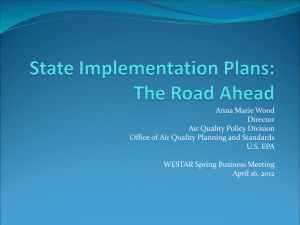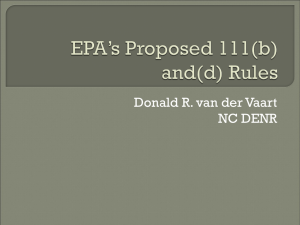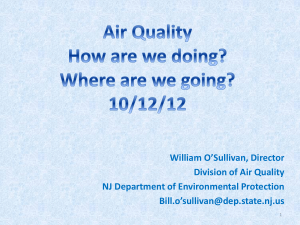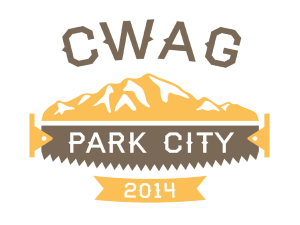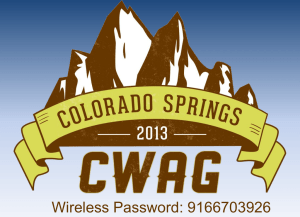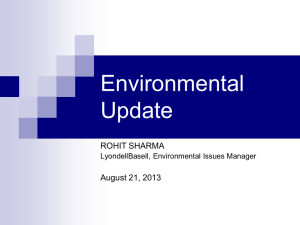Presentation - State/Local Air Pollution Control Agencies
advertisement
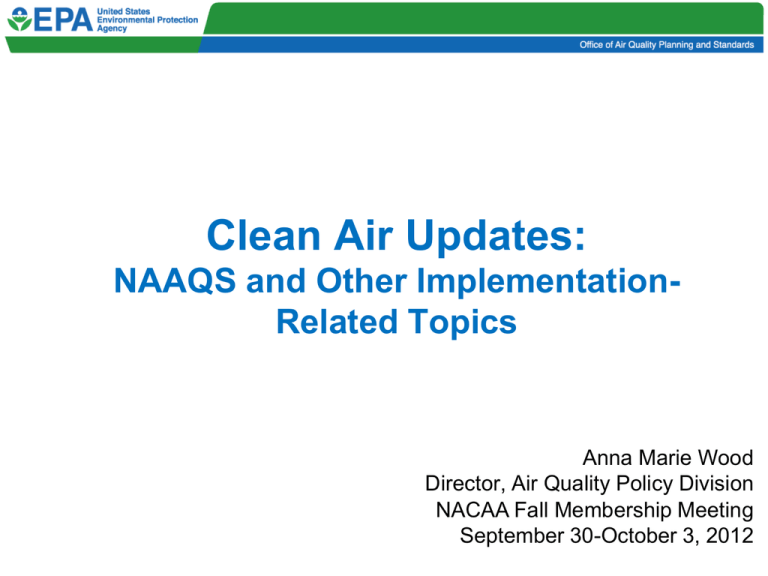
Clean Air Updates: NAAQS and Other ImplementationRelated Topics Anna Marie Wood Director, Air Quality Policy Division NACAA Fall Membership Meeting September 30-October 3, 2012 Outline of Presentation • • • • • • • • • NAAQS: Anticipated Schedules and Implementation Updates Infrastructure and Interstate Transport Regional Haze Exceptional Events Rule Implementation Guidance Interim Policy on Wildfires and Prescribed Burns GHG and Title V Permitting New Source Review SIP Improvements Questions or Comments 2 NAAQS: ANTICIPATED SCHEDULES & IMPLEMENTATION UPDATE 3 Current Schedule for Ongoing NAAQS Reviews (updated September 2012) POLLUTANT MILESTONE NO2/SO2 Secondary PM Ozone Lead NO2 Primary SO2 Primary CO NPR Jul 12, 2011 Jun 14, 2012 2013 Feb 2014 Aug 2015 Feb 2016 Jul 2016 NFR Mar 20, 2012 Dec 14, 2012 2014 Nov 2014 May 2016 Nov 2016 Apr 2017 NOTE: Underlined dates indicate court-ordered or settlement agreement deadlines. 2008 Ozone NAAQS Designations and Implementation • Final Area Designations – 46 areas designated nonattainment including 2 separate tribal areas • Only 3 had never before been designated nonattainment for ozone – Designations effective July 20, 2012 (77FR30088 and 77FR34221-Chicago) • Ozone Designations Petitions – Received 30 petitions for reconsideration • 6 Nonattainment Areas: Atlanta, GA; Charlotte, NC-SC; ChicagoNaperville, IL-IN-WI, Dallas-Fort Worth, TX; Knoxville, TN; Memphis, TN-AR-MS • 1 Unclassifiable Area: Uinta Basin, UT • 15 Attainment Areas (in 8 states) - Petitioner requesting EPA designate these areas nonattainment based on 2011 rather than 2010 air quality data – 16 petitions for review filed with the court 5 Nonattainment Areas for 2008 Ozone NAAQS (Effective July 20, 2012) Tuscan Buttes Sacramento Sheboygan Upper Green River Basin Jamestown Allentown Cleveland Chico Chicago Nevada Co Calaveras Co Mariposa Co Denver San Joaquin Valley San Luis Obispo St. Louis Cincinnati Washington DC/VA E. Kern Co Ventura Co West Mojave Knoxville Morongo Tribe LA-South Coast Charlotte Riverside Co Memphis Pechanga Tribe San Diego Imperial Co Phoenix Atlanta Dallas Baton Rouge Houston New York Philadelphia Pittsburgh Uintah Basin Dukes MA Reading Lancaster Columbus San Francisco Greater Connecticut Seaford DE Baltimore 2008 Ozone NAAQS Designations and Implementation (cont.) • 2008 Ozone NAAQS Classifications Rule – Signed April 30, 2012, effective July 20, 2012 (77FR30160) – Established classification thresholds and end-of-year attainment dates – Reclassified 6 areas in California that had previously requested bump-up for 1997 NAAQS – Revoked the 1997 standard, effective July 20, 2013, only for purposes of transportation conformity • 2008 Ozone NAAQS SIP Requirements Rule – Rule and guidance addressing SIP requirements under Subpart 2 – Current schedule under development 7 Overview of 2008 Ozone SIP Requirements Rule • Options are discussed for: – Deadlines for emission inventory, RFP, RACT, RACM, and attainment demonstration SIPs – Flexibility in meeting Reasonable Further Progress (RFP), including precursor pollutant substitution – Reasonably Available Control Technology (RACT) reviews and compliance deadlines – Contingency measure flexibility for Extreme areas – Baseline and periodic emissions inventory submissions – Defining the “MSA” criteria for Rural Transport Areas – Revoking 1997 NAAQS and anti-backsliding provisions • We briefed states on the draft proposal in July and next step is OMB review 8 Widespread Use of Onboard Refueling Vapor Recovery and Stage II Waiver • Final rule effective May 16, 2012 (77 FR 28772) • August 7, 2012, issued guidance for states on: – Methodologies to demonstrate compliance with specific CAA provisions in sections 110(l)and 193 governing EPA approval of SIP revisions – New technical and policy guidance for areas of the Ozone Transport Region (OTR) on implementing measures under CAA section 184(b)(2) capable of achieving emissions reductions comparable to those achievable by Stage II controls 9 Revisions to Implementation Rules for 1997 8-Hour Ozone NAAQS • Classification of former subpart 1 areas under subpart 2 – On April 27, 2012, finalized revisions to the 2004 Phase 1 rule that air agencies would follow to meet the 1997 8-hour ozone NAAQS [77 FR 28424] – 16 ozone nonattainment areas classified under Subpart 1 were reclassified as Marginal or Moderate under Subpart 2 – Areas have until June 13, 2013 to provide any outstanding SIP elements unless area has Clean Data Determination • RACT/RACM policy proposal – Revise presumption that NOx SIP Call and CAIR satisfy nonattainment area RACT/RACM requirements for covered sources – Currently developing proposal schedule • RFP credit final rule for emissions reductions outside ozone nonattainment areas – Issued proposal on December 2010 to limit RFP credit only to reductions “in the area,” in response a petition for reconsideration and a related court decision on RACT policy limiting RACT controls to “in the area” – Schedule under development 10 Ozone Advance Program • Program, launched in April 2012, encourages emission reductions in ozone attainment areas – Designed to help attainment areas work proactively to stay in attainment – Does not establish new requirements or defer/avoid any existing requirements – Over 17 states and tribes are currently participating • Participation Benefits: – – – – – – – Receive EPA support Rallying point for public/stakeholder awareness and involvement Develop framework for action Emphasis on multi-pollutant reductions Recognition and opportunity to highlight measures/programs Stakeholder group formation and engagement Potential to implement measures early and efficiently • Information can be found at www.epa.gov/ozoneadvance 11 Ozone NAAQS Litigation • Continues to shape the interpretation for CAA requirements for active and revoked standards. • Drives schedule for SIP actions and findings. • See Appendix for specific information 12 PM2.5 NAAQS Proposal: An Overview • Proposal signed June 14, 2012; final due December 14, 2012 • Highlights of proposal include: – Primary PM2.5 standards: lower annual primary standard within the range of 12.0 to 13.0 micrograms per cubic meter (µg/m3) (seeking comment down to 11.0 µg/m3); retain existing 24-hour standard level of 35 µg/m3 – Secondary PM2.5 standard: set a separate standard to address visibility effects, primarily in urban areas – PM10 standard: retain existing 24-hour standard of 150 µg/m3 – Monitoring: add 52 near-road PM2.5 monitors – Implementation: proposed action on two permitting issues, solicited input on other issues 13 PM2.5 NAAQS Proposal: Proposed Changes to Permitting Provisions • Changes would ensure that changes to the PM standards will not delay pending permits or reduce potential burdens to permit applicants • Changes would: – Grandfather permit applications if a draft permit or preliminary determination has been issued for public comment by the date the revised PM standards become effective – Provide a “surrogacy approach” that would allow, for purposes of the proposed secondary visibility index, permit applicants to rely on their analysis demonstrating that PM2.5 emissions increases would not cause or contribute to a violation of the 24-hour mass-based standards 14 PM2.5 NAAQS Implementation • Attainment demonstration SIPs due December 2012 – 20 of 32 areas attaining based on 2009-2011 data • Guidance for 2006 standards (issued March 2, 2012) – Clarified several issues, including RFP milestone years, seasonal emission inventory issues, policy for contingency measures – Earthjustice filed litigation on this guidance, and EPA filed a Motion to Dismiss in July 2012 15 PM2.5 NAAQS Implementation (cont.) • Infrastructure litigation and SIP obligations for PM2.5 NAAQS – Based on a consent decree related to the 2006 PM2.5 NAAQS infrastructure SIPs, there are upcoming deadlines for EPA action (proposal or final) on one or more elements of 20 states' SIPs (including interstate transport SIPs) between now and October 2013 • For 2012 standards (projected), planning to issue implementation rule by time designations are effective – Estimate early 2015 – Consulting with NACAA PM2.5 implementation policy group on potential implementation issues with new standards (PSD, designations, SIP guidance) 16 Progress on Ozone and PM2.5 Attainment (as of September 2012) 1997 8-hr Ozone 2004 designations 1997 PM2.5 2005 designations 2006 PM2.5 2009 designations Initial Nonattainment Areas 113 39 32 Redesignations Approved Areas 72 4 0 Current Nonattainment Areas 41 35 32 Clean Data Determinations 23 42 9 Pending Proposed Redesignation Requests 0 5 1 17 SO2 NAAQS Implementation • New primary SO2 1-hr standard (75 ppb) promulgated in June 2010 • Designations – July 27, 2012 FR notice extends to June 2013 the date for completing designations for all areas – SIPs due 18 months after effective date of designations. EPA provided draft guidance for comment in Fall 2012. Intend to issue final guidance for State plans to show attainment in nonattainment areas by the time that nonattainment area designations are effective • Implementation for areas without violating monitors – Recognition that some areas without monitors likely have violations – Announcement on April 12, 2012 stated that EPA is no longer expecting the June 2013 section 110 infrastructure SIPs to include modeling demonstrations showing attainment in “remaining” areas – EPA issued May 2012 White Paper describing monitoring and modeling options for implementing the standard in areas not initially designated nonattainment – Expect to issue rulemaking or guidance to clarify the designations approach for the remaining areas of the country 18 SO2 Monitor Design Values 2008-2010 SO2 Monitoring Data 59 violating monitors in 18 states and 1 territory, (48 counties) 2008-2010 design values 19 SO2 NAAQS Implementation • State Comments – Use threshold concept to address largest sources (e.g., 2000 tons/yr) – Allow flexibility to use monitoring and/or modeling in SO2 implementation process – Redeploying monitors will be possible in limited cases only – If EPA establishes new modeling or monitoring requirements, do it through rulemaking 20 SO2 NAAQS Implementation (cont.) Enviro. Group Comments Industry Comments • Use 3rd party modeling in designations process prior to June 2013 • Address largest sources first • Issue guidance ASAP regarding modeling of actual emissions (as surrogate for monitoring air quality for 3 recent years) for use in designations • Concurrently involved in title V permit renewal actions to ensure sources show compliance • Need rulemaking and additional time for any new implementation requirements • Most support basing designations on monitoring data only • If modeling for designation is used, it should be based on actual emissions 21 NO2 NAAQS Implementation • 1-hr 100 ppb standard promulgated January 2010 • Guidance on NO PSD permit modeling issued June 2010 and March 2011 (http://www.epa.gov/NSR/guidance.html) • Designations of “unclassifiable/attainment” for all areas became effective in February 2012 • New monitoring network: Of the 126 near-road sites required, EPA has funded 52 sites (one site in each CBSA with population > 1 million) 2 – Current deadline for all monitoring sites to be operational is January 1, 2013 – EPA has committed to do a rulemaking to extend this deadline and to phase-in required sites • Infrastructure SIPs due January 2013; guidance planned 22 INFRASTRUCTURE AND INTERSTATE TRANSPORT 23 Infrastructure SIP Obligations NAAQS Due date under CAA Notes 1997 Ozone July 2000 July 2010 Consent Decree: Obligations remain for only 1 state (MT) Fall 2011 Settlement Agreement: Obligations remain for 6 states; most deadlines in 2012 (Idaho as late as 2014) 2008 Ozone March 2011 Draft i-SIP guidance anticipated later in 2012 (combined for ozone, NO2, SO2). 1997 PM2.5 July 2000 October 2008: Made findings of failure to submit for 21 states/territories. 2006 PM2.5 Sept 2009 September 2011: Made findings of failure to submit for 8 states. Oct 2011 Consent Decree: Obligations for 20 states; most deadlines for EPA final action in 2012 (AR, NM in 2013). May 2012: Amended complaint filed for 9 states; CD deadlines likely. 2008 Lead (Pb) October 2011 Infrastructure SIP guidance issued in October 2011. NOI received June 2012, mostly for failure to submit. 2010 NO2 January 2013 Draft infrastructure SIP guidance anticipated later in 2012. 2010 SO2 June 2013 Infrastructure SIP guidance proposed in September 2011; revised draft guidance anticipated in late 2012. 24 Infrastructure SIP (i-SIP) Issues • EPA is in the process of developing i-SIP guidance that covers the 2008 Ozone NAAQS as well as the 2010 NO2 and SO2 NAAQS • EPA position on four specific issues: • • • • Excess emissions of a facility at times of startup, shutdown, or malfunction (“SSM”) Director’s discretion Minor source NSR program NSR Reform amendments – Existing SIP provisions concerning these issues can be dealt with separately, outside the context of acting on the new i-SIP submissions – EPA’s action to approve a state’s new i-SIP submission must not be misinterpreted as re-approval of the existing SIP provisions that address the above issues • Sierra Club filed a petition for rulemaking in June 2011 concerning SIP provisions for Startup, Shutdown, and Malfunction (SSM) in 39 states – EPA entered into settlement agreement to act on the petition by August 31, 2012 (this deadline has been subsequently extended) – EPA is currently drafting a proposed rulemaking, likely to include SIP calls 25 2006 PM2.5 and 2008 Ozone NAAQS Interstate Transport SIP Litigation • Transport SIPs for 2006 PM2.5 NAAQS were due September 2009 – EPA made findings of failure to submit for 29 states in June 2010 and for TN in July 2011. FIP deadline for several states was July 2012 because of June findings – Based on a consent decree for i-SIPs, there are upcoming deadlines for EPA action on 20 states' SIPs between now and October 2013 – Recent complaint amended by Sierra Club (4/24/12) for failure to take final action on 9 states’ SIPs and to make finding of failure to submit for 2 states SIPs • Transport SIPs for 2008 ozone NAAQS were due March 2011 – Deadline suit filed by WildEarth Guardians and Sierra Club to compel the Agency to make findings of failure to submit ozone infrastructure SIPs for 2008 NAAQS and to take final action on the SIPs for TN and KY also covers transport SIPs • Litigation currently stayed 26 Interstate Transport Litigation • CSAPR: – Court decision in EME Homer City Generation v. EPA on August 21, 2012 to vacate and remand the rule – CAIR remains in place pending promulgation of a replacement rule • EPA assessing implications of court decision in following areas: – Interstate Transport SIP actions for 2006 PM2.5 and 2008 ozone NAAQS – Redesignation requests for PM2.5 and Ozone NAAQS – SIP Attainment Demonstration approvals – Action on Regional Haze SIPs that relied on CSAPR Betterthan-Bart rule 27 REGIONAL HAZE 28 Consent Decrees for Regional Haze • EPA has entered into multiple consent decrees which have established schedules for taking action on all regional haze SIPs – • The consent decrees resulted from the litigants filing complaints for EPA’s: – – • Failure to take action on submitted SIPs for states that did not receive a “finding of failure to submit” notice in January 2009 Failure to promulgate FIPs for states that did receive a 'findings' notice The largest consent decree with NPCA et al. involves 48 separate actions – • Consent decrees are with WildEarth Guardians (WEG), National Parks Conservation Association (NPCA) et al., Sierra Club, and Kentucky Environmental Foundation Some states involve more than one action – e.g. in Tennessee, there is one action for the entire state SIP and a second for a SIP revision for a specific facility (Eastman) To date, we have taken final action on 29 of 52 plans – By November 15, 2012, the EPA will have taken more than 100 proposed and final actions on SIPs for regional haze 29 Regional Haze SIP and FIP Actions Approved (inc. D.C.) 15 Approved + CSAPR FIP 11 Proposed Approval (inc. AK) 4 Partial Approval (no disapprovals) 3 Approved but needs CSAPR SIP within 2 years 2 SIP Approval Actions Full FIP (MT & HI) Final 3 Proposed 1 Limited disapproval for CAIR. No other action. 1 SIP Partially Disapproved with 2-year FIP clock 2 Proposed Full FIP (Virgin Islands) 2 Final Partial FIP* (inc. FCPP) 6 FIP Actions (*status of rest of SIP varies) Proposed Partial FIP* 4 30 Other EPA Actions on Regional Haze SIPs • CSAPR Better-than-BART Rule – Final rule issued June 7, 2012 (77 FR 33642), effective August 6, 2012 – Allows CSAPR states to meet the BART requirements for EGUs with CSAPR programs – Eleven states have partial “friendly” FIPs that substitute CSAPR trading programs for source-specific BART for EGUs, as applicable – In light of CSAPR decision, we will need to assess our options going forward • FIPs (as of September 1, 2012) – One final full FIP (Montana) – Six final partial FIPs: San Juan Generating Station in NM (Administrator stay), Four Corners Power Plant in NM, 3 power plants in OK (court-ordered stay), 2 power plants in ND, 2 power plants in NY, and 1 power plant in NV – Two proposed full FIPs: Hawaii and U.S. Virgin Islands – Proposed partial FIPs: non-EGUs (taconite, cement, and paper) in MI, taconite in MN, several power plants in WY and 3 power plants in AZ 31 Regional Haze SIPs – Periodic Review • Periodic report describing progress toward reasonable progress goals [§51.308(g)] and [§51.309(d)(10)] – Report is due 5 years from submittal of the initial SIP under 308, and in 2013 under 309 – Evaluate adequacy of existing plan and act accordingly [§51.308(h)] • 5-year reports due: – December 2012 for North and South Carolina because SIPs submitted in 2007 – 2013 for Utah, New Mexico, and Wyoming (under §309). – Between 2013 and 2017 for the rest of the states depending on the submittal date • National consistency process established through EPA’s Regional Haze workgroup so questions can be addressed 32 EXCEPTIONAL EVENTS AND WILDFIRE POLICY 33 Exceptional Events Rule Implementation Guidance • Published a Notice of Availability on July 6, 2012 for comments on the revised draft guidance documents and tools to assist in implementing the rule • Draft guidance includes: – Frequently asked questions – High winds document – Response to Comments document summarizing EPA responses to issues raised by air agencies and other stakeholders during 2011 “informal” comment period • Draft guidance documents are available at: • Exceptional Events website (http://www.epa.gov/ttn/analysis/exevents.htm) • Docket for this action – EPA-HQ-OAR-2011-0887 (http://www.regulations.gov) • Comment period ended on September 4 and received 46 comments • Plan to release final guidance as final product or as interim step prior to rule revisions in late 2012 34 Revision to Interim Policy on Wildfires and Prescribed Burns • Draft revision to address managing air quality impacts from wildfires and prescribed burns was submitted for OMB review in January 2010 – Policy intended to replace 1998 “Interim Air Quality Policy on Wildland and Prescribed Fires” • EPA withdrew draft policy because of concerns identified by other federal agencies, including concerns over agriculture burning • EPA has convened several meetings with federal agencies to better understand their specific concerns and identify issues • Current internal EPA HQ and Regional efforts include identifying possible scope and issues to address “replacement” policy 35 GREENHOUSE GAS AND TITLE V PERMITTING 36 GHG Implementation: Tailoring Rule • January 2, 2011, EPA and states began PSD permitting for GHGs under the Tailoring Rule Step 1 – For “anyway” sources and modifications • Tailoring Rule Step 2 began July 1, 2011 – Continued Step 1 applicability and swept in “non-anyway” sources and mods • Tailoring Rule Step 3 issued on June 29, 2012 – Maintains the Step 1 and 2 thresholds • 5-year GHG NSR study in 2015 and Step 4 final rule planned for 2016 37 GHG Permit Issuance Responsibility • In 2010, EPA took a series of actions to ensure that permitting would continue without disruption after January 2, 2011 when GHG emissions became subject to PSD regulation – “SIP Call” required 13 states to revise their PSD programs to cover GHG emissions – 9 areas still have a FIP for only the GHG portion of the PSD program – One local program has no permitting authority for GHGs but EPA has proposed approval of its SIP program 38 GHG: Permitting Update • 50 GHG permits issued as of early September 2012 – 8 of these by EPA; all others issued by state/local permitting authorities – GHG BACT has usually required energy efficiency measures • EPA is currently reviewing 39 GHG permit applications where EPA will issue the permits • GHG Operating Permits: Existing sources without a Title V permit that have ≥100K TPY CO2e and ≥100 TPY Mass are now required to submit an application to their permitting authority (starting on July 1, 2012) 39 GHG: Permit Applications • Approximately 160 PSD permit applications have been submitted to states and EPA that either address GHGs or may have to address: – – – – 50 permits with GHG limits have been issued 43 permit applications are pending at EPA 12 pending permits are draft permits issued by states 55 permit applications do not address GHG at this time since application is on-hold, there is on-going litigation, etc. • The 50 PSD permits with GHG limits were issued in 7 source categories: – – – – – – – EGU Oil and gas Minerals and metals Chemicals Cement Pulp , paper and wood products Ethanol 40 Key Permitting Issues • Adequate Basis for BACT Decisions – – – – Consideration of energy efficient units Rejection of CCS Lack of numerical limits or explanation Little or no approach to GHG measurement • EPA continues to stress the importance of documentation of GHG control considerations and BACT limits • Consideration of Carbon Capture and Storage (CCS) 41 CAAAC GHG Permit Streamlining Workgroup • Purpose: Develop and recommend potential streamlining approaches for GHG permitting • Membership: State and local agencies, tribes, industry, attorneys, one environmental group and consultants • Charge: – – – Review and confirm EPA-identified streamlining methods and source categories, and expand on what EPA has identified thus far Identify the regulatory and policy barriers associated with further development of permit streamlining methods Prioritize the streamlining methods and source categories and recommend an implementation approach for each method 42 CAAAC GHG Permit Streamlining Workgroup: Current Status • Active from April 2012 to September 2012 • Final report completed: • Provides summary of GHG permit streamlining information received either through EPA's Tailoring rule process or the workgroup's efforts to collect additional information • Does not offer recommendations due to resource and time constraints • Asks EPA to solicit stakeholder feedback on the options through rulemaking. No recommendation on the timing of this rulemaking was given by the workgroup • CAAAC voted to forward report to EPA for consideration on September 20 43 Biomass and GHG Permitting • Biomass Deferral – In July 2011, EPA issued a rule to defer permitting for biogenic CO2 emissions for a period of three years. Applies to CO2 emissions only • EPA sent biomass accounting framework to Science Advisory Board (SAB) in September 2011 • Next steps: – SAB to issue letter on biomass scientific study (Fall 2012) – EPA to address SAB comments as appropriate 44 Title V Permit Petitions • Existing backlog of petitions and large volume of new petitions – We respond to about 12 – 15 petitions per year • Petitioners continue to be very aggressive seeking deadlines for responses – We have recently started working on response schedules outside of court deadlines (letter of intent) • Many of the issues presented continue to be related to New Source Review 45 NEW SOURCE REVIEW 46 PM2.5 Modeling Guidance • Issued guidance on March 23, 2010 for NAAQS compliance demonstration based on PM2.5 • 2nd round guidance expected to be released by early 2013: – Draft version will be available for review and comment in Fall 2012 on EPA’s Support Center for Regulatory Atmospheric Modeling (SCRAM) website – PSD modeling of PM2.5, screening nature, consultation & protocol – Compliance demonstration for direct and secondary (precursor) emissions – Modeling of PM2.5 direct emissions – Options for the assessment of secondary formed PM2.5 – Representative background concentrations – Comparison of modeled and monitored results to NAAQS 47 PM2.5 Increments, SILs, SMC • Final rule published on October 20, 2010 – Established a July 20, 2012 deadline for states to submit NSR SIP revisions – By invoking CAA 166(b), this rule gives EPA an atypically short deadline (November 20, 2012) by which to act on submissions • Established PM2.5 increments for Class I, II and III PSD areas – “Major source baseline date” - October 20, 2010 – “Trigger date” - October 20, 2011 – “Minor source baseline date” - To be determined by 1st PSD permit application in an attainment/unclassifiable area. • Established Significant Impact Levels (SILs) and Significant Monitoring Concentration (SMC) – SILs: Class I, II and III (annual, 24-hr) – SMC – Both SILs and SMC are discretionary for States 48 PM2.5 Increments, SILs, SMC (cont.) • Litigation – EPA received reconsideration request from TCEQ and Sierra Club • EPA granted on minor procedural issues – no stay of the rule – but we were subsequently sued by Sierra Club on PM2.5 SILs and SMC – Litigation is under way, challenging EPA’s legal authority to use SILs and SMC and de minimis demonstration for PM2.5 SILs and SMC – EPA supports both PM2.5 SILs and SMC but requested that Court remand and vacate regulatory text at paragraph (k)(2), pertaining to application of PM2.5 SILs. We did not acknowledge any legal problems with SMC 49 PM and Condensable Emissions • 2008 PM2.5 NSR Implementation Rule amended definition of “regulated NSR pollutant” to require CPM for PM10 and PM2.5 – Definition inadvertently required that “PM emissions” include CPM • On March 16, 2012, proposal revised definition to remove CPM requirement for “PM emissions” – Include CPM only if required by specific NSPS or a SIP – Final rule anticipated in Fall 2012 50 SIP IMPROVEMENTS 51 SIP Reform: What Challenges are We Addressing? • We have heard very clearly from states that they would like to work with us on ways to improve the SIP process to: – make it more efficient – ensure that EPA is engaging with the states early—both at the NAAQS-setting process and through the development of implementation guidance and rulemakings • NACAA and ECOS formed a workgroup in June 2010 to address long-standing issues – The mission is to make the process more efficient and effective while ensuring the fulfillment of statutory responsibilities to attain the NAAQS – Working collaboratively, the workgroup created a list of the 13 highest-priority potential SIP process reforms. 52 13 ECOS/NACAA Priority Items • The 13 items fall under two broad areas of concern: – Timely completion of EPA guidance documents, including state involvement in the guidance and rulemaking development process – Consistent, timely, and efficient SIP processing • Most of the priority items can be accomplished through EPA working closely with our state partners • Additionally, ECOS asked the Agency to work on EPA-State Pilots for improving regulatory implementation – The pilot for air programs was to explore implementation issues for NAAQS – The PM2.5 Full Cycle Analysis Project (FCAP) is intended to address this request 53 Actions to Improve Consistency, Timeliness and Efficiency in SIP Processing • We are making progress! • We have implemented the following tools: – Issued SIP consistency memo in April 2011 which addresses submittal requirements, provides clarity on clean data vs. redesignation requests, and addresses the use of letter notices and guidance on SIP submittal letter and public notice procedures (publically available) – Implemented Key Performance Indicators (KPIs) to track and report on reduction of the SIP backlog (internal to EPA only) – Development of a national SIP tracking data base to be launched in 2013 to help manage the KPIs and identify the national policy issues that are keeping us from approving SIPs (tracking internal to EPA but reports shared externally) 54 Actions to Improve Consistency, Timeliness and Efficiency in SIP Processing (cont.) – Implemented a national SIP Dashboard to track and address unresolved national policy issues to ensure they get resolved (internal to EPA only) • Over the last year, we’ve reduced the issues from 20 to approximately 4 that we still need to be addressed – Established and implemented an “Elevations Protocol” for elevating issues for resolution that create or perpetuate SIP backlogs (publically available) • We expect that the protocol should lead to more timely resolution of issues holding up SIPs from being processed – Provided SIP planning toolkits for states (publically available) 55 Actions to Improve the Timely Completion of EPA Guidance and Rulemakings and to Involve States Earlier in the Process • In April, we joined with NACAA and ECOS to launch the PM2.5 Full Cycle Analysis Project (FCAP) • Current focus is on the PM2.5 NAAQS but we expect lessons learned to serve as a model which can be transferred and used for future NAAQS implementation • FCAP is focused on engaging with the states on the full cycle of any NAAQS – From standard setting to the end of the planning cycle using the recently proposed PM2.5 NAAQS as a vehicle to assess what is needed, when it is needed, and how best to engage early with states to facilitate efficient and effective NAAQS implementation 56 Actions to Improve the Timely Completion of EPA Guidance and Rulemakings and to Involve States Earlier in the Process (cont.) • We teed up several implementation issues in the proposed NAAQS, including prevention of significant deterioration (PSD), as well as target timelines for issuance of guidance and rulemakings related to SIPs – We have started engaging with states on these specific PM2.5 implementation issues through regularly scheduled discussions • We envision additional efforts to work with states to develop SIP templates and other tools that can facilitate more efficient SIP processing • The ultimate goal for FCAP is to develop a roadmap to use as a tool for planning and carrying out implementation -- We’ve already started planning for the 2014 Ozone NAAQS! 57 Questions or Comments 58 APPENDIX 59 Anticipated NAAQS Implementation Milestones (updated September 2012) Final NAAQS Date (or Projection) Infrastructure SIP Due Designations Effective Attainment Demonstration Due Attainment Date PM2.5 (2006) Oct 2006 Oct 2009 Dec 2009 Dec 2012 Dec 2014/2019 Pb Oct 2008 Oct 2011 Dec 2010/2011 June 2012/2013 Dec 2015/2016 NO2 (primary) Jan 2010 Jan 2013 Feb 2012 none none SO2 (primary) June 2010 June 2013 TBD TBD TBD Ozone (2008) Mar 2008 Mar 2011 July 2012 2015 2015/2032 Dec 2012 Dec 2015 Early 2015 2018 2020/2025 2014 2017 2016 2019 2019/2036 Pollutant PM (current review) Ozone (current review) 60 Revisions to Implementation Rules for 1997 8-hr Ozone NAAQS • Classification of former subpart 1 areas under subpart 2 (final rule) – On April 27, 2012, EPA finalized revisions to the 2004 Phase 1 rule that State, tribal and local air pollution control agencies would follow to meet the 1997 8-hour ozone NAAQS [77 FR 28424]. Effective June 13, 2012 – This action resulted in 16 ozone nonattainment areas, previously classified under Subpart 1, reclassified as Marginal or Moderate under Subpart 2 provisions of the CAA – Areas have until June 13, 2013 to provide any outstanding SIP elements unless area has Clean Data Determination, which suspends certain planning requirements • RACT/RACM policy proposal – In response to July 2009 court remand this rulemaking would revise the presumption that NOx SIP Call and CAIR satisfy nonattainment area RACT/RACM requirements for covered sources – We are in the process of evaluating when we will propose the rule • RFP credit final rule for emissions reductions outside ozone nonattainment areas – Proposed December 2010 to limit RFP credit only to reductions “in the area,” in response a petition for reconsideration and a related court decision on RACT policy limiting RACT controls to “in the area” – We are in the process of evaluating when we will take final action on the rule 61 1-Hour Ozone NAAQS Litigation • In response to litigation, EPA has published final determinations of failure to attain the 1-hour ozone standard for San Joaquin Valley, South Coast, and Southeastern Desert – Environmental groups filed a Petition for Review challenging the obligations that result from the failure to attain determinations of a revoked NAAQS – Briefing has been delayed until mid-October 2012 • Section 185 Fee Program SIP Actions for 1-hour NAAQS – EPA has approved alternative “not less stringent” programs for South Coast and SE Desert • Final approval of San Joaquin Valley program on August 20, 2012 • Final approval of South Coast program signed September 21, 2012 – TCEQ is developing an alternative program for Houston – Section 185 “Termination Determinations” have been proposed for Sacramento and finalized for Baton Rouge. The 3 States of NY City area have also submitted requests • Termination determination is a maintenance plan surrogate 62 1997 Ozone NAAQS Litigation • Court-driven deadlines for infrastructure SIP actions for several states – Based on settlement agreements and consent decrees related to the 1997 8hour ozone NAAQS infrastructure SIPs, there remain upcoming deadlines for EPA action (proposal or final) on one or more elements of 6 states' SIPs between now and June 2014 • August 6, 2012 proposed consent decree to address a Sierra Club lawsuit that establishes deadlines for EPA to act on various SIP submittals – The lawsuit claims EPA failed to take action within 18 months on certain SIP submissions for the states of MA, CT, NJ, NY, PA, MD and DE – The comment period closed on September 5, 2012 • Sierra Club filed petitions for review of EPA’s final actions approving redesignations of East St. Louis (IL), Milwaukee, and Chicago (IL) – They are challenging whether cap-and-trade rules without emissions caps on individual sources represent “permanent and enforceable” SIP measures in maintenance plans 63 2008 Ozone NAAQS Litigation • Petition for review filed by Earthjustice and others on failure to complete the reconsideration action on the 2008 ozone NAAQS – Case dismissed February 17, 2012 finding EPA took no final action – EPA intends to complete the reconsideration as part of the 2013/2014 review • Lawsuits challenging the level of the 2008 Ozone NAAQS remain active – Industry, environmental groups, and EPA have filed briefs, and oral argument is scheduled for November 16, 2012 64 2008 Ozone NAAQS Litigation (cont.) • Deadline suit filed by WildEarth Guardians and Sierra Club to compel the Agency to make findings of failure to submit ozone infrastructure SIPs for 2008 NAAQS and to take final action on the SIPs for TN and KY – Litigation currently stayed • Deadline suit for failure to issue PSD regulations (e.g., PSD increments) for 2008 ozone NAAQS under section 166 of the Act – EPA filed a partial motion to dismiss arguing no duty to issue a Section 166 rule for revised NAAQS – May 7, 2012 the Court held that the CAA did not require EPA to promulgate additional regulations for ozone following revised NAAQS – August 15, 2012 the plaintiff filed an appeal of this decision 65 2008 Ozone NAAQS Litigation (cont.) • Sierra Club has sued EPA for failure to establish a deadline for states with nonattainment areas to submit SIPs for the 2008 ozone NAAQS – They argue that per CAA section 172(b), EPA has a duty to set a SIP due date at the time we promulgate designations 66


